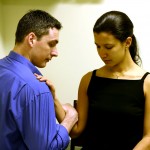Cunningham
Cf. Luxation de l'épaule
Vidéo youtube
Cunningham Technique:
- Seat the patient comfortably, as upright as possible, with shoulders relaxed.
-
Face directly opposite to the patient and kneel next to them – this avoids any external rotation/flexion of the humerus (which happens if you start off too far away from your patient).
- This closeness to the patient also means that they are resting their hand on your shoulder, not reaching for it and clutching with the fingers. Encouraging the patient to relax verbally and with massage, followed by slow, gentle movements will allow you to get to your starting position. Don’t pull, you’ll only get spasm, pain and an uncooperative patient.
- Supporting the affected arm, slowly and gently move the humerus into full adduction
- Instead of supporting underneath the affected limb, grip the forearm or elbow with gentle but steady pressure


- Gently massage the trapezius and deltoids; this helps to relax the patient and reassures them that the doctor is not going to do anything painful.
- Then, move on to gently massaging the biceps at the mid-humeral level.
- Ask the patient to shrug her shoulders (superiorly, posteriorly), continuing the biceps massage.
- With the humerus adducted, the biceps shortened and the operator’s wrist resting on the patient’s forearm, the patient will usually immediately feel more comfortable. The humerus can be gently moved forwards and back in order to find the perfect angle.
- Wait for the patient to relax fully, and the humeral head will slip back into place. (Warn the patient that it may feel strange as this happens and not to fight against the movement.)
Non indiqué chez:
- Les obèses (adduction impossible): faire la methode de Milch modifiée (On ne peut pas faire Kocher non plus)
- Les personnes non détendues
Sources



